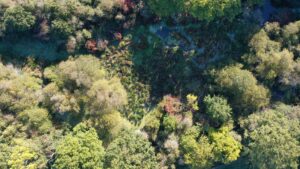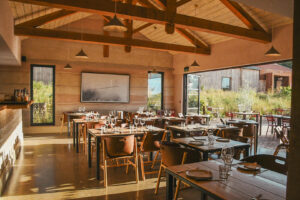
Knepp’s 2025 in numbers
knepp’s 2025 in numbers 2025 has been quite a year. Our butterfly summer was record-breaking, we re-launched the Knepp Wilding Podcast with Isabella Tree as
Last guaranteed pre-Christmas order date for Butchery and Gift items: 16th Dec. Dismiss
Skip to contentHome / The Journey to Wilding the Garden ~ Nov 2020
The first frosts came, sprinkling icing sugar on the lawns. The hardy plants and skeletal seed heads wore crystal halos like characters from The Snow Queen. The Dahlias and nasturtiums suffered sudden and total collapse, their cell walls ruptured, their leaves a dark slime. But the tubers have been quietly harvesting energy for next summer’s green shoots while the nasturtiums have been dropping their seed bombs in the hundreds all through the season.
There was a rush to finishing cleaning the greenhouse and constructing a trial insulated mini-tent for the more tender houseplants. Last year we found bubble –wrapping one side of the whole structure both time consuming and not ideal in terms of plastic use. We’ll see as the winter progresses whether it’s a workable system.
As the last tomatoes and cucumbers were harvested and the sprawling plants taken down, we realised the extent of the whitefly population. A thorough clear- out, clean-up and cut-back was embarked upon, and a three-pronged attack of sticky traps, SB plant invigorator and Encarsia was employed. Normally, these parasitic wasps that lay their eggs in the larvae of whiteflies work best in the summer months, but we have had cold nights followed by bright sunny days that have permeated the greenhouse with heat; it was worth a try.
Broad beans and peas were sown, and the seedlings of cornflowers, poppies, marigolds, Nigella and Ammi major were already peeping their heads above the compost. We’ve also planted up some big pots of parsley, coriander and dill so there are fresh herbs for Christmas and the winter salads are thriving despite the whitefly attack.
With a second lock-down begun, and our heads turned to the past year we’ve been reflecting on our journey as horticulturalists, and how we’ve been energised and challenged by the immersion in the rewilding story.
The Agricultural Bill was in the midst of being batted backwards and forwards between Parliament and The House of Lords, debating the new framework of farming and land management after our departure from the EU. There are some positive outcomes, where farmers are to be rewarded for environmental benefits. These include measures such as improved air and water quality, higher animal welfare and flood management. We as gardeners are on our own journey, traditional horticulture rarely mixing with agriculture, yet much of our self-education around soil has been from the regenerative farming movement.
We have travelled from the broad basics of identifying an acid or alkaline soil and the N, P, K nutrient content to aiming to be able to identify and quantify the value of microbial and fungal soil life in the garden. Whilst farming has an enormous responsibility to the land and to the quality of the food it produces as Abby Rose so brilliantly discusses in the podcast The Doctor’s Kitchen, gardeners bear the same obligation to plants and soil biota. If it is possible, by education and understanding, for your plot to be as healthy as possible without the aid of chemical fertiliser or weed killer, would not most people see that as an ideal to work towards?
Our relationship with Vidacycle and those gifted folk at Soilmentor continues to grow. We’re hoping to organise a training day where all the elements of Knepp, the ecology, the regenerative farming and the garden departments will come together and hopefully create an estate-wide program of understanding and development of the basis of all the above-ground successes. An exciting day to look forward to, in a year full of challenges.

Verbena bonariensis
The garden is split; those areas planted up in the spring left to die back and give overwintering habitat to invertebrates, berries and seeds for birds. The cutting bed by the greenhouse, the asparagus bed, and all the raised vegetable beds cleared and bare but for a few straggling annuals, ready for Anthony Riggall the landscaping contractor to begin Phase Two of the redesign.
The oak leaves are toffee, caramel, ginger, floating slowly to ground leaving the black bones of the trees against ashes–of-roses skies. Reminding us to adjust the pace, find moments of quiet, let the frenzied pace ebb.
Moy Fierheller Joint Head Gardener November 2020
Spotlight on soil: farming returns to its roots – Positive News – Positive News
Who Feeds Us? #1: The Hungry Gap – Farmerama Radio

knepp’s 2025 in numbers 2025 has been quite a year. Our butterfly summer was record-breaking, we re-launched the Knepp Wilding Podcast with Isabella Tree as

Knepp Wilding Kitchen- Restaurant Supervisor Job Description We are looking for a dynamic, enthusiastic and experienced front-of-house professional looking for a new challenge and to

Moy Fierheller | Deputy Head Gardener Published December 2025 Visit Knepp’s rewilded Walled Garden November begins with warmth and rain. The remnants of Hurricane Melissa that caused tragedy and catastrophic
Knepp Wildland Safaris, our gardens and campsite are all about the quiet and patient observation of nature.
Some of the species we are likely to encounter are shy or can be frightened by loud noises or sudden movements. Our campsite with open-air fire-pits, wood-burning stoves and an on-site pond is unsuitable for small children.
For this reason, our safaris, garden visits, holiday cottages and campsite are suitable only for children of 12 and over.
You’ll receive relevant offers and news by email. This will include information about the Rewilding Project, online store products, the Wilding Kitchen Restaurant / Cafe, and other exciting experiences / events across the Knepp Castle Estate. For more information, view our Privacy Policy.